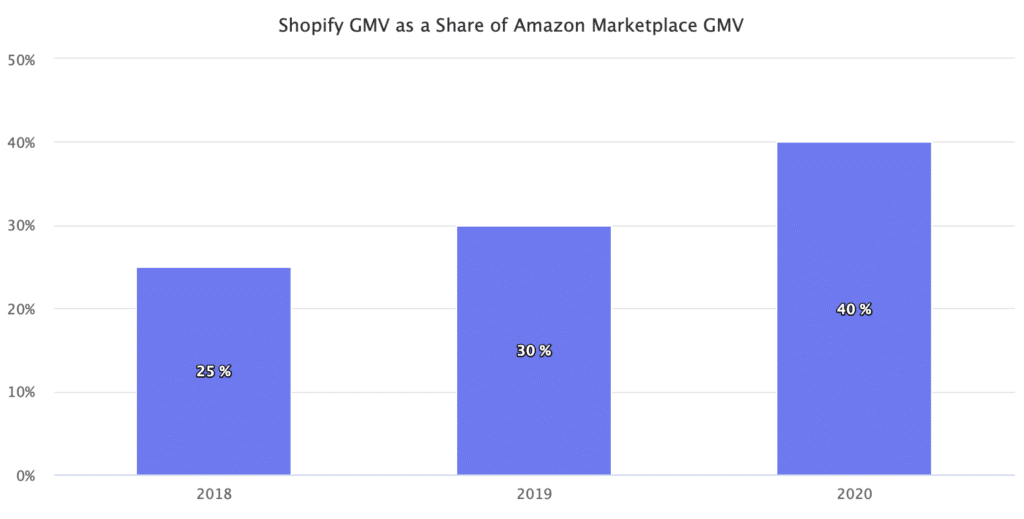The Canadian online store giant Shopify has experienced a real boom in recent years. What began in 2004 as a simple Modular system of a German expatriate is now a comprehensive store solution that is valued by small businesses, start-ups and retailers all over the world.
But what exactly does the company do? Who is behind Shopify and how has the store provider developed in recent years? This time we analyze the History of Shopify and look at what makes the company second largest e-commerce company in North America.
From snowboard store to modular system
The History of Shopify begins with the German expat Tobias Lütke. The programmer living in Canada had completed a series of development jobs, felt burnt out and decided to open an online store for snowboards in 2004.
Together with his friends Daniel Weinand and Scott Lake He founded "Snowdevil" in the same year and set out to find a simple system for the snowboard store. The founder realized that there was no Simple modular systems for creating an online store. Especially for less tech-savvy entrepreneurs, setting up a store was a real challenge back then. complicated matterwhich was associated with many hurdles.
Lütke saw this problem as an opportunity for his company and decided to develop a simple applicable and Intuitive online store system for everyone. The "Snowdevil" snowboard store first became "Jaded Pixels" before the Company 2006 was renamed to "Shopify".
In the same year, the Online store platform of Shopify online. However, as Shopify hardly invested in growth in the first few years, the number of users increased only slowly. In 2008, Lütke therefore Silicon Valley searched for investors and received some Promising offers. However, these offers were linked to the company relocating its headquarters to California. As Lütke had the corporate culture there however, no deal could be agreed with investors. So it took another two years before Shopify was really greater awareness achieved.
In 2010, Shopify organized a Competition. The Shopify merchant should work with the highest turnover receive a MacBook Pro free of charge within 2 months. The friendly author, blogger and business angel Tim Ferriss advised Lütke to increase the prize money to 100,000 dollars in order to reach as many people as possible. In the end, the competition was a complete success. Within a short time 1,400 new dealers were welcomed to the platform and Lütke was able to raise venture capital from investors for the first time.
Over the next few years, Shopify, equipped with a total of over 120 million in venture capitalsignificantly and was able to gain more and more users. The platform also continued to develop steadily. But more on that later.
Credits: Roberto Cortese from Unsplash
Development into an e-commerce giant
2015 saw the Shopify goes public. In conjunction with the IPO, the Canadian company also pursued an aggressive Growth strategy. Although this meant that Shopify was closed until 2019 No black figures but was able to increase sales and user numbers exorbitantly.
Looking at the Company figures before & after the IPO, the rapid growth particularly clearly. In the very first year after the IPO, sales rose to 390 million dollars be doubled. By the end of 2017, the share price had risen by 588 %, the Enterprise value at EUR 11.6 billion and there were already 400,000 stores, that were created with Shopify.
Fueled by the Corona pandemic and the resulting digitalization of many small trading companies Shopify has grown strongly again in the last two years. In 2020, there were already over 1 million dealersthat rely on Shopify as their store system. In addition, sales have risen to over 2.9 billion dollars increased and a profit of over EUR 300 million be booked in.
In the meantime, the largest companies of the world rely on Shopify's e-commerce solutions. These include Google, Facebook, Tesla, General Electric and the best-known online retailers such as Kylie Jenner with her beauty products.
Shopify's share price is one of the best-performing of the S&P 500 stocks and (as of August 2021) stands at just under 1,450 dollars per share. This gives Shopify a Market capitalization of over 181 billion US dollars and is, behind Amazon, the largest second largest e-commerce company in North America.
Shopify's business areas & business model
At its core, Shopify is a Modular systemwhich is designed to make setting up an online store as simple and intuitive as possible. Over the years, however, Shopify has developed even further and ventured into other business areas, making it one of the most powerful online shops today. Plug-and-play complete solution for online stores. The platform is extremely user-friendly and (unlike other store solutions on the market) combines many features in one product and at one price.
On the one hand, Shopify merchants can choose from a variety of templates - which makes the initial creation of a store child's play makes. On the other hand, individual products, product descriptions, images and the checkout process can be easily integrated into the Admin Dashboard can be configured. Shopify also offers numerous features for marketers. For example, a blog can be created, SEO texts or numerous marketing key figures can be called up and evaluated in the statistics.
Shopify also scores highly in terms of compatibility and integrations. Merchants do not need a separate database, but can use Shopify's practical cloud database. There are numerous interfaces to all common Merchandise management and ERP systems and countless apps with which you can customize the store to your own needs. Shopify stores can also be linked relatively easily with other marketplaces such as eBay or Amazon.
However, as already mentioned, Shopify is now in other business areas active. In 2019, CEO & founder Tobias Lüttke decided to buy a robotics company for 450 million dollars in order to automate Shopify's warehouse. The company thus took a major step into the logistics sector. With the in-house "Buy Now"- button in Facebook Stores has also created an easy way to sell products to social media users. Also in the Online marketing areah is where Shopify operates. Large companies such as Red Bull and Budweiser use the software to run major marketing campaigns. With its Marketplace, Shopify also creates opportunities for companies to network with designers, developers and experts.
The main beneficiaries of Shopify are Small and medium-sized enterprisesstart-ups and stores with a small number of products. This customer group is the backbone of the Shopify Community and accordingly the business model of the Canadian e-commerce provider aadapted to this target group.
In principle, the use of the Shopify software with costs. Prices start at 9 dollars per month for the Starter Lite plan and go up to 299 dollars per month in the individual price levels. Shopify Plus prices for large customers start at 2,000 dollars per month. You also have to pay for the use of apps & integrations with Shopify.

Pricing Shopify - Screenshot from shopify.com/prices
But the Monthly subscription fee & the app fees are only one part of the business model. The second major pillar of the business model is Shopify Payments. Shopify Payments is the payment service that can be used to process payment transactions for orders. This includes, for example Credit card purchases, Instant bank transfers, EPS transfers, Klarna and much more. The company charges a transaction fee for this. This means that the company earns approx. 2% Commission fees and is more or less involved in the success of the merchants. Current figures show that Shopify Payments is now responsible for a large part of the company's turnover.
With this solution, Shopify is evolving more and more from an e-commerce provider to a FinTech and Payment service provider. Newer business areas such as Shopify Capital, where stores are granted loans to buy the store's inventory, confirm this trend.
Shopify in comparison with other store solutions
Of course, Shopify is not the only e-commerce provider on the market. There are numerous competitors such as Magento, WooCommerce or BigCommerce. While the comparison between Shopify and the individual providers can of course be very detailed - we would rather limit ourselves to the essentials in this article.
One of the Main distinguishing features between the Canadian software provider and the other leading e-commerce providers is that Shopify is a commercial product, so you have to pay to use it, whereas Magento or WooCommerce for example, are open source (i.e. free of charge). Shopify also comes with its own hosting solution (i.e. the website is hosted on Shopify's servers). For open source providers, you usually need your own hosting provider.
Above all, the ease of use makes Shopify a much better solution for beginners. However, it is also the only platform that allows you to create your own Transaction fees This is an essential disadvantage, especially for larger stores. With Shopify, it is also easy to need several apps for the store and therefore have to pay additional fees. Apps are usually also available free of charge from open source providers.
It is therefore not surprising that Shopify is used more by small companies & start-ups - whereas Magento or WooCommerce are preferred by larger companies due to their greater complexity and installation requirements.
Shopify vs. Amazon
Last but not least, we would also like to introduce Shopify to the E-commerce giant Amazon compare. After 2020 was a record year for the online shopping market, we would like to take a closer look at the balance of power between the two North American giants.
Basically, it is difficult to compare Amazon and Shopify because they are very different companies with barely comparable business models. While Shopify is the first port of call for your own online store, Amazon is the Internet marketplace and e-commerce retailer par excellence. What makes the two companies comparable, however, is how much revenue individual, independent brands and retailers can generate through direct sales to customers via the respective platform.
Amazon is a leader with its Marketplace continues to be the market leader. In 2020, the US group processed transactions with a value of around EUR 300 billion from. This is an increase of almost 50% compared to the previous year. Shopify stores, on the other hand, achieved sales of EUR 119 billion in 2020. This means that the Canadian company's retailers achieved a Increase in sales 96% compared to the previous year.
Shopify is therefore approx. 40% the sizee from Amazon. Compared to the last few years, the Difference in size however, is gradually decreasing. While the company was still around 25% the size of Amazon in 2018, it has been able to significantly increase its share in the last two years.
 Gross merchandise value Shopify as a share of Amazon's gross merchandise value - Source: https://www.marketplacepulse.com/articles/shopify-is-40-as-big-as-amazon-marketplace
Gross merchandise value Shopify as a share of Amazon's gross merchandise value - Source: https://www.marketplacepulse.com/articles/shopify-is-40-as-big-as-amazon-marketplace
The Business models of both companies are different and they are not in direct competition. Nevertheless, the figures show a trend that could potentially be dangerous for Amazon: When Shopify was founded, Amazon was the most efficient channelto reach new customers. However, since Shopify was founded, more and more merchants are selling directly to customers (D2C model). If one compares the growth rates, it can be assumed that Shopify Amazon already in 5 years could overtake.
While Shopify as a company will still be significantly smaller than Amazon Although Amazon's e-commerce business will not be the only one, it shows that Amazon is not an invincible top dog in the e-commerce sector and that there is still plenty of potential for other companies, especially in the D2C market.
Conclusion - Shopify a company analysis
The Canadian e-commerce company Shopify has succeeded in developing an easy-to-use modular system for online stores. This has enabled it to grow rapidly in recent years and become the second largest E-commerce companies in North America. Shopify is the ideal solution for Small and Medium-sized entrepreneurwho want to sell products in their own store.
The innovative business model ensures that Shopify is indirectly involved in the success of its stores and is therefore making more and more inroads into the market. FinTech makes. In our opinion, this makes the Canadian company a promising companiesthat Amazon is the market leader in the D2C range can dispute.
How does Shopify earn money?
The use of Shopify is subject to a fee. Prices start at 9 dollars per month for the Starter Lite plan and go up to 299 dollars per month in the individual price levels. Shopify Plus prices for large customers start at 2,000 dollars per month. The second major pillar of the business model is Shopify Payments.
Who is bigger - Shopify or Amazon?
Amazon remains the market leader with its Marketplace. The US group processed transactions worth around EUR 300 billion in 2020. This is an increase of almost 50% compared to the previous year. Shopify stores, on the other hand, achieved sales of EUR 119 billion in 2020.


